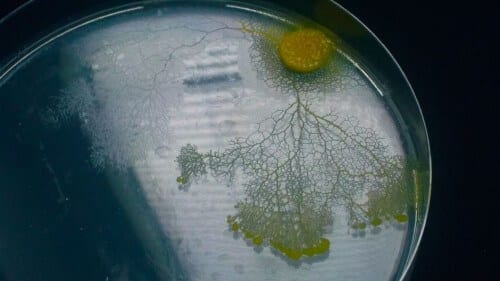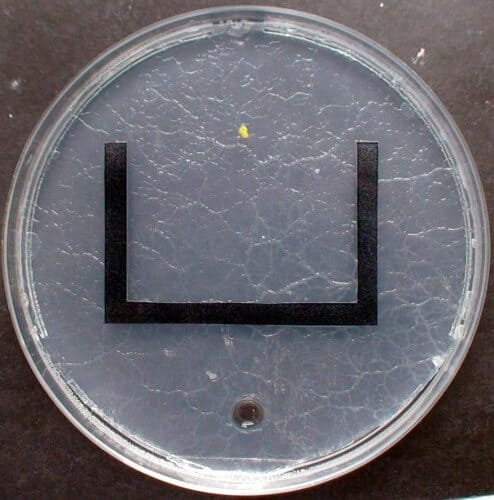Almost all animals have a brain, or at least a nervous system, that allows them to remember signs and perform the calculations necessary for successful navigation. But it turns out that even a brainless creature is capable of remembering and navigating
Noam Levithan and Yonat Ashhar Galileo

When we try to get from one place to another, for example to go to work or to walk the path of Israel, we navigate and orient ourselves in space with the help of a mental map of our surroundings, and according to various road signs such as signs, paths, a familiar tree or a pile of stones that we remember from the previous trip. Other animals also use signs and external cues to orient themselves in space. Migratory birds navigate, among other things, according to road signs that they see, such as buildings and the Earth's magnetic field, as well as with the help of familiar smells. Navigator ants (Cataglyphis) navigate through them according to the angle of the sun and the number of steps they have taken since leaving the nest. Other types of ants use volatile substances (pheromones) to mark the paths leading from the nest to the food sources. Almost all animals have a brain, or at least a nervous system, that allows them to remember signs and perform the calculations necessary for successful navigation. But it turns out that even a brainless creature is capable of remembering and navigating.
Chris Reid (Reid) from the University of Sydney and his colleagues examined, in an article published in the scientific journal PNAS, the navigational ability of the mucous membrane of Physarum polycephalum - an amoeba-like single cell (which of course lacks a brain and nervous system), which belongs to the group of plasmodial mucous membranes. The mucosa is a large multinucleated cell and moves in its environment similar to an amoeba, while putting out extensions in several directions. As it moves, it leaves behind traces of transparent mucus composed of sugar-proteins (glycoproteins).
Reed and his colleagues noticed that when searching for food, the slime tends to avoid entering areas already covered in mucus, meaning it doesn't waste time retracing its steps. The researchers showed that the mucosa does avoid mucus using a simple maze in the shape of the letter Y. They placed food, oat flakes, at the end of each of the two arms of the maze, and let the mucosa choose between the arms. Since there is no preference for one arm over the other, the mucous membranes choose between the arms at random. But when the researchers covered one of the arms of the maze with slime, almost all the slimes chose to look for food in the other arm, which was clear of slime, the one that supposedly had no slime in it before them. The choice to avoid the slime-covered path and walk the clean path is not automatic but is made as a choice. When the researchers covered the two arms of the maze with mucus, so that there was no preferred and clean path, the mucus did not avoid the two arms but again chose between them at random, without showing a preference for one arm or the other.

After confirming their hypothesis that the mucosa uses the mucus channels as a way to mark places it has already visited, Reid and his colleagues tested its navigational ability. To do this they adopted a test commonly used to study the autonomous navigation ability of robots, the ability to bypass an obstacle in the shape of the letter U. They placed mucous membranes on one side of a Petri dish filled with jelly (agar) and placed on the opposite side as a target a food source, a sugar solution, the concentrations sample which she created along the jelly pulled the examined mucosa towards her. The researchers placed the obstacle in the shape of the letter U between the mucous membranes and the food source, so that if the mucous membrane moves straight towards the sugar - the shortest path - it will get stuck in the obstacle and will have to find a way around it to reach the food.
The test was done on clean petri dishes as well as on those that were covered in advance with mucus. Reid and his colleagues hypothesized that if the mucous membranes do use mucus as a kind of waymark (in fact - "no entry"), the plates already covered in mucus will prevent them from creating new signs, "memories", and therefore it will be much more difficult for them to overcome the obstacle and reach the food. Indeed, 96% of the mucous membranes that navigated across clean plates managed to reach the sugar before the end of the 120 hours allotted to them:
In contrast, mucous membranes that could not create new memories got in their way. Although their movement rate did not change, they spent ten times more time scanning areas they had already visited before and in the end only 33% of them reached the target in time. Even those who reached the goal, did so by a much longer route and required a much longer time compared to the mucous membranes that moved on the clean plates.
Previous studies show that the mucosa is capable of performing actions that apparently require intelligence, such as solving mazes, operating simple robots and making decisions, and it can also be taught to respond to stimuli and anticipate them. The current study also adds a type of external chemical memory to the list of properties of the mucosa. Reed and his colleagues believe that external memory, like the mucus that marks the mucosa where it has visited, helped ancient creatures to overcome various challenges even before the development of the nervous system, and that it is the first step in the evolution of the internal memory that exists in creatures with brains, like us.
for further reading
The original article:
Reid, CR, Latty, T., Dussutour, A. & Beekman, M. Slime mold uses an externalized spatial "memory" to navigate in complex environments. PNAS 109, 17490-17494 (2012). doi: 10.1073/pnas.1215037109
Yonat Ashhar and Noam Levitan, "Ririt's Memories", "Galileo" 115
Noam Levithan and Yonat Ashchar, "Irrational mucosa and not by chance", "Galileo" 146
The original article appeared in Galileo magazine, December 2012

3 תגובות
That is, in the case of the ants, they prefer to follow the path (scent path) created by the other ants, in contrast to the mucous membrane that avoids the path of its group mates.
Maybe it's better:
http://www.youtube.com/watch?feature=endscreen&NR=1&v=UZ2HTTeM3aQ
I think it's a bit funny to call it a "memory". By the way, this is reminiscent of the behavior of ants, only with them it's the other way around, they wander around the area randomly until they identify food and then they create a "trail" of chemical smell that guides the other ants to the place. The more ants follow this route, the stronger the scent and the easier it is for the other ants to follow.
A nice experiment is to create a winding route (closed with partitions) from the nest to the food, and at some point remove the partitions and see how the ants continue to follow the same "invisible" route (which, as mentioned, is not straight).
There are many computer simulations that demonstrate the idea:
http://www.youtube.com/watch?v=8F6caMF7MXg